

Dr. Ellen Ochoa, first Hispanic woman in space, to keynote 2018 SACNAS – The National Diversity in STEM Conference
“…Ellen Ochoa
SACNAS is excited to announce that trailblazer Dr. Ellen Ochoa, the first Hispanic woman ever to go to space will keynote 2018 SACNAS – The National Diversity in STEM Conference. Dr. Ochoa is also only the second female Director of NASA’s Johnson Space Center—where she led the human space flight enterprise for the nation from 2013 to 2018…”
Link to article
Humanity’s Genes Reveal Its Tangled History
…”Reality, it turns out, is more complex and interesting than scientists ever imagined.
In the early 19th century, Jean-Fraconnçois Champollion used the Rosetta Stone to begin the process of deciphering the hieroglyphics of ancient Egypt. We already knew Egypt through the Bible and the histories of the Greeks, but even Herodotus wrote 2,000 years after the beginning of the Old Kingdom. With the translation of hieroglyphics, the legend of Egypt came to life. What had been cloudy became clear.
In Who We Are and How We Got Here: Ancient DNA and the New Science of the Human Past, David Reich, a geneticist at Harvard’s Medical School and the Broad Institute, introduces us to the 21st-century Rosetta Stone: ancient DNA, which will do more for our understanding of prehistory than radiocarbon dating did. Where the latter allowed archaeologists to create a timeline based on the material objects they excavated, DNA sequencing allows scholars to explore the genetics of the people who created those material cultures. We may never see the face of Agamemnon, but we already have the DNA of the warlords of Mycenaean Greece, and in the future we could reconstruct their features from genes alone…”
Link to article
Testing the Water
Hydrologist Hugo Loáiciga’s early work on global warming and the hydrologic cycle significantly enhanced today’s grasp of this topic long before there was an appreciation of its impacts.
Now, for his “groundbreaking and eminent contributions to the understanding of the effects of climate processes on the recharge and the safe yield of aquifers and the improvement of groundwater management,” Loáiciga, a professor…Loáiciga received a Bachelor of Science degree in civil engineering from the Universidad de Costa Rica and both a Master of Science and a doctorate in water resources and hydrology from UC Davis. His research interests include planning, design and analysis of water resources systems and theory as well as computational aspects of surface and groundwater hydrology. He served as a member of the city of Santa Barbara’s Water Commission for six years and joined the faculty at UCSB in 1988…”
Link to article
Interdisciplinary art installation displays symbiosis of people, nature
The Art | Sci Center gallery replaced paintings and sculptures with mosses, plants and mushrooms Thursday.
The UCLA gallery housed “Vivarium: A Place of Life,” an art installation by graduate design media arts student Maru García. It consisted of two biospheres – one filled with plants and other natural organisms, such as mushrooms and mosses, and another featuring a performer interacting with the ecosystem, demonstrating activities such as drinking water and eating seeds. García said she wanted visitors at the exhibition to gauge the interconnectedness of humanity and the natural world as they walk through…
Link to article
To attract more blacks and Hispanics to STEM, universities must address racial issues on campus
ROY, N.Y. — Rensselaer Polytechnic Institute was not Tiana Young’s first choice for college, even though Young wants to dual major in aeronautical and mechanical engineering, and the private university is one the top schools in the country for science, technology, math and engineering.
The school had one big drawback: Rensselaer’s student body is more than two-thirds white and Asian, according to federal data. For Young, who is black and whose high school in Spring Valley, New York was almost entirely African-American and Hispanic, “the lack of diversity was a very big concern,” says the freshman…
First Stanford Latina physics Ph.D. fights for STEM inclusion opportunities
The victory of becoming the first Mexican woman to earn her Ph.D. in physics at Stanford University was hard-won for Dr. Deborah Berebichez (pictured), who’s faced objection to her desire to work in science, technology, engineering and math, or STEM, since childhood.
“I was told from a very young age that physics was for geniuses and that I had better pick a more feminine path. … When I confessed to my mom in high school that I loved physics and math, she said, ‘Don’t tell the boys, because you’ll intimidate them, and you may not be able to get married,’” Berebichez said…
Link to article
3 reasons for the declining number of Latino physicians
The U.S. Hispanic population has seen significant growth (link is external) in past 50 years, so how is it that fewer Latinos are becoming physicians?
Earlier this year, Latino Leaders Magazine reported on this decline (link is external): a 2015 study, conducted by the Center for the Study of Latino Health and Culture (link is external) at UCLA, indicates that the number of Latino physicians dropped 22 percent over a 30-year period.
1980: 135 Latino physicians per 100,000 Latinos
2010: 105 Latino physicians per 100,000 Latinos…
Link to article
This Chicana chemist is paying it forward to support students from underrepresented groups
On a calm September evening in 2010, Alegra Eroy-Reveles had come home from lab and put her toddler to bed when a dear friend called. As they talked, Eroy-Reveles scribbled with a marker on the mirrored closet door, like she did on fume hoods in the chemistry lab where she worked as a postdoc at the University of California (UC), San Francisco. The conversation touched on proteases, probes, experiments that weren’t working, and her disillusionment with the pressure to publish. But it took a turn when the friend said she was dying of breast cancer…
Link to article
Number of minorities, women taking CS is skyrocketing thanks to STEM collaborations
- Following implementation of a new type of computer science option last fall — AP Computer Science Principles, which puts real-world perspectives on coding — data from 2016 to 2017 shows the number of minorities taking a computer science exam in some form nearly tripled to 22,199, up from 8,283, while the number of girls taking it rose from 12,642 to 29,708.
- AP CSP was born out of a collaboration between the National Science Foundation, College Board and Code.org, along with other authorized providers, who are rolling out the course and training teachers to facilitate it, reports NPR — and over half of the schools teaching the course are using curriculum from Code.org, which trained 500 teachers last year…
Facebook Researchers Shut Down Artificial Intelligence That Created It’s Own Language
Facebook has recently developed a new artificial intelligence (AI), and it has since created its own language using code words to communicate more efficiently. Researchers promptly shut the system down over concerns that they might lose control over the A.I.
This isn’t the first time AIs have diverged from their training in the English language to develop their own, more efficient language. While the resulting phrases from this condensed method of communication sound like gibberish to the human ear, they do in fact make semantic sense when interpreted by AI agents…
Link to article
How this grassroots environmental justice hero is leading his hometown resistance
The activist mark! Lopez didn’t attend his first march for environmental justice on foot. He was pushed in a stroller. A winner of this year’s Goldman Environmental Prize for grassroots “heroes”, Lopez has agitated alongside his family since childhood.In the late 1980s, when he was growing up in East Los Angeles, Lopez’s grandparents and others took down a proposed state prison, a toxic waste incinerator, and a pipeline planned to run near a school. The 32-year-old Lopez stepped up to help lead the battle against the Exide battery smelter — a factory just outside East L.A.’s borders that for decades spewed noxious chemicals, like lead and arsenic, into neighboring communities that are mostly inhabited by people of color. Activists in the area fought the company for years — citing public health concerns related to lead contamination, such as impaired neurological development in children and increased violence in exposed communities — and the plant officially closed in 2015. Cleanup, however, for which the state set aside $176.6 million, has barely gotten underway and has already hit roadblocks…
Mexican-American Biologist Speaks On Science’s Continued Diversity Problem
It wasn’t that long ago that a science professor could easily tell a struggling female student that women just don’t belong in chemistry.
As an undergraduate at the University of Washington in the 1960s, Lydia Villa-Komaroff was determined to be a chemist, but sought help from her advisor.
“Well of course you’re having difficulties,” the professor said, according to Villa-Komaroff. “Women don’t belong in chemistry.”..
Link to article
Alfredo Quinones-Hinojosa, M. D., Mexican American Professional
Alfredo Quiñones-Hinojosa (also known as “Dr. Q”) is a neurosurgeon, author, and researcher. Currently, he is the “William J. and Charles H. Mayo Professor” and Chair of Neurologic Surgery and runs a basic science research lab at the Mayo Clinic Jacksonville in Florida. In recognition of his work, Dr. Quiñones-Hinojosa has received many awards and honors, including being named as one of the 100 most influential Hispanics in the U.S. by Hispanic Business Journal in 2008; as 2014 Neurosurgeon of the Year by Voices Against Brain Cancer, where he was also recognized with the Gary Lichtenstein Humanitarian Award; and by the 2015 Forbes magazine as one of Mexico’s most brilliant minds in the world…
Link to biography
Mexican American Proarchive: Annual Report on Mexican American Professionals
News from the census American Community Survey is generally good for the 2015 year. Mexican American college enrollment was up from 18.7% to 18.9% in the 2014 and 2015 years. Graduate or professional degree attainment was also up from 2.9% to 3.0%. The number of bachelor’s degrees granted to Mexican American students rose from 7.6% in 2014 to 7.8% in 2015.


In spite of these gains, Mexican Americans still remain at the bottom of the ladder when it comes to earning a bachelor’s degree. Even after broadening the group to Latinos or Hispanics, this group still lags behind. According to the Pew Hispanic Center: “As of 2014, among Hispanics ages 25 to 29, just 15% of Hispanics have a bachelor’s degree or higher. By comparison, among the same age group, about 41% of whites have a bachelor’s degree or higher (as do 22% of blacks and 63% of Asians).” Pew reports that the main reasons for this low graduation rate is that Hispanics are less likely “to enroll in a four-year college, attend an academically selective college and enroll full-time.”
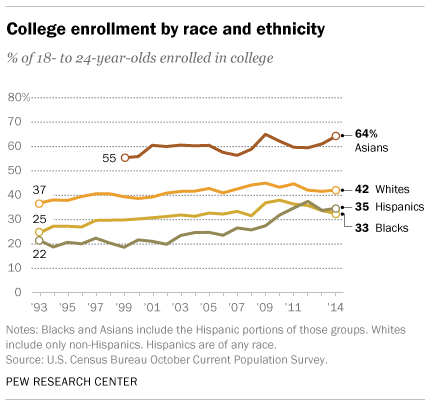
Also in the good news column, the University of California will continue to push for a greater number of underrepresented minorities; namely, Chicano/Latino students whose resident freshmen numbers rose from 2.7% to 32.3% of admitted California freshmen. In other good news, the proportion of Chicano/Latino students transferring from community colleges increased to 29.3% from 26.8% for 2015.
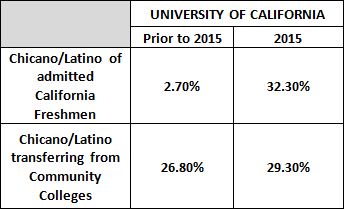
Occupations, including those in management, business, science, and art, fared better for Mexican Americans. The number of Mexican Americans filling these occupations rose from 17.4% in 2014 to 17.5% in 2015.

The total number of Hispanics filling these occupations was 16.1% in 2015, a bit lower than Mexican Americans specifically.
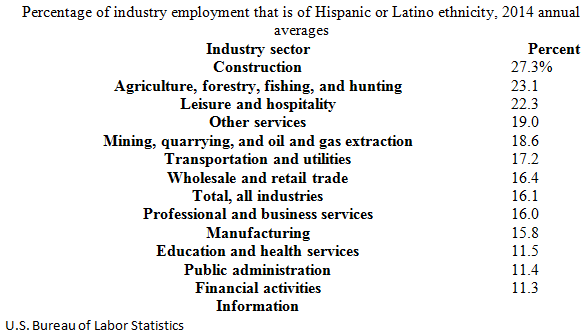
The report shows that industrial employment for Mexican Americans remained the same for 2014 and 2015 at 10.2%.
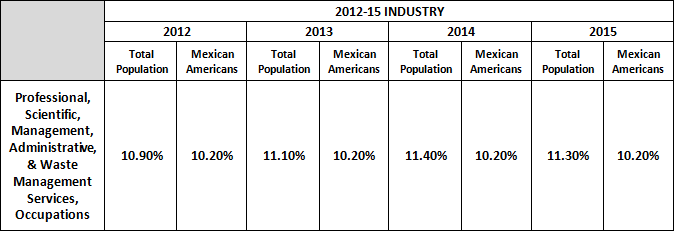
The figures for Hispanic or Latino employment for 2015 and 2016 show a healthy increase.
According to the Pew Hispanic center, “Construction, professional and business services, health services, financial services and food services…showed healthy gains.” Most of the jobs gained by native-born Hispanic workers were in manufacturing, mostly durable goods (82,000 Hispanic workers in this industry), followed by wholesale and retail trade (79,000), publishing, broadcasting, communication and information services (55,000), and construction (54,000).
Foreign-born Hispanics had the most job gains in construction (417,000), followed by business and professional services (179,000). Together, those two industries accounted for almost three-quarters (74%) of all jobs gained by foreign-born Latinos between 2005 and 2006.
The business and professional services sector, which ranges from management and technical services to janitorial, landscaping, and waste management services, is also a key employer for non-Hispanic workers. Of the total increase in employment in 2005-06, non-Hispanic workers accounted for 410,000 employees in the industry, native-born workers 327,000, and foreign-born workers 83,000.
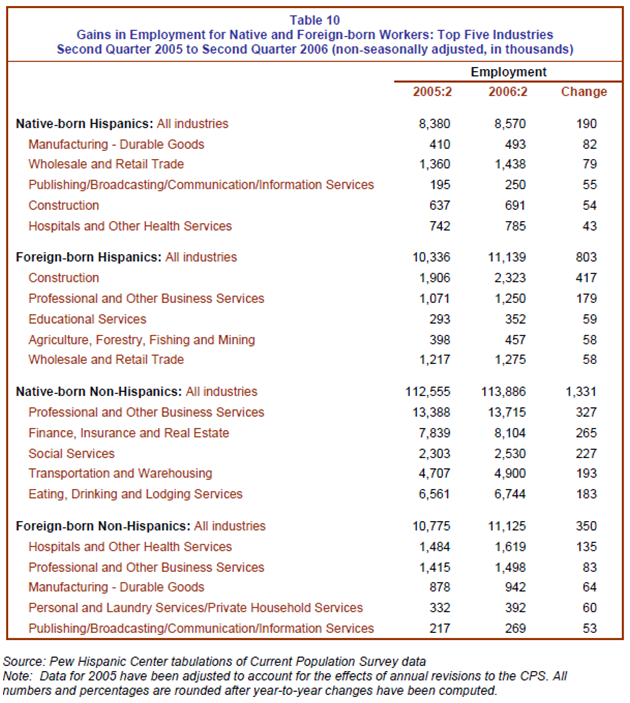
Sources
- Census Bureau, Selected Population Profile in the United States: 2015
- Pew Research Center
- University of California
- Bureau of Labor Statistics
Raciolinguistics” How Language Shapes our Ideas about Race
AF Ball – 2016
… Gordon, University of Arizona 3. From Mock Spanish to Inverted Spanglish: Language Ideologies
and the Racialization of Mexican and Puerto … University of South Carolina 5.“Suddenly Faced
with a Chinese Village”: The Linguistic Racialization of Asian Americans 97 adrienne …
Link to book preview
Hispanic Association of Colleges and Universities President to speak at National Latino Climate Leadership Forum
Hispanic Association of Colleges and Universities (HACU) President Antonio R. Flores will be a speaker on the session “Building Leadership – Who, How, What’s Needed,” at the National Latino Climate Leadership Forum 2016 on June 17 in Washington, D.C. The forum has invited over 75 national Hispanic and Latino health, faith, business, education, culture, community, government and environmental leaders to discuss and explore Latino leadership on climate solutions…
Link to article
5 Latinos Forging New Ground and Breaking Barriers
We’re all familiar with prominent Latinos who have broken barriers to become national and international household names – from Rita Moreno and Gloria Estefan to JLo and Pitbull. Or think Sonia Sotomayor or Pulitzer prize-winner Junot Díaz.
Here’s a small list of Latinos who are breaking barriers in their professions and leaving their mark as they shake things up. They range from ranging from multi-millionaire techies to VJs and Vine stars. They’re in different stages of their trajectories, and they’re all fascinating…
Link to article
Ancestry variation and footprints of natural selection along the genome in Latin American populations
L Deng, A Ruiz-Linares, S Xu, S Wang – Scientific Reports, 2016
… 2. Basu, A. et al. Genome-wide distribution of ancestry in Mexican
Americans . Hum. Genet. 124, 207–214 (2008). …
Link to report
Writing the Good Life: Mexican American Literature and the Environment
PS Ybarra – 2016
… Writing 3 1 epistemological hierarchy and the environment: erasure of Mexican American
Knowledge in … The professionals at the New Mexico State Archives answered questions before
I … I have met so many colleagues at conferences and through professional organizations …
Link to book preview
John G. Florez Chemical engineering has taken this ACS Scholar around the world
Mexican American chemical engineer John G. Florez, 39, grew up with his parents working seven long days each week in their car body shop in the town of Las Cruces, N.M., close to the Mexican border. “We were pretty challenged financially,” Florez says. Neither of his parents had a college education. But both encouraged their son to get one as a vehicle to a better life…
Link to article


